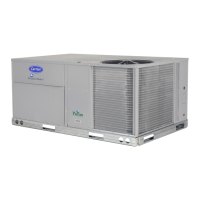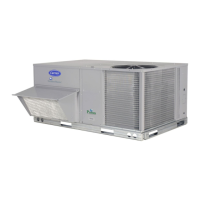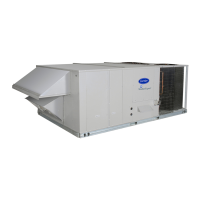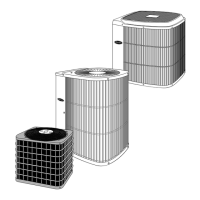Do not leave system open to atmosphere any longer than
minimum required for installation. POE oil in compressor is
extremely susceptible to moisture absorption. Always keep
ends of tubing sealed during installation.
To prevent compressor damage DO NOT bury more than 36
in. of refrigerant tubing. If ANY tubing is buried, provide
6-in. vertical rise at service valve.
Outdoor units may be connected to indoor section using accessory
tubing package or field-supplied refrigerant grade tubing of correct
size and condition. Tubing diameters listed in Table 1 are adequate
for equivalent lengths up to 50 ft For tubing requirements beyond
50 ft, substantial capacity and performance losses can occur.
Follow the recommendations in the Application Guideline and
Service Manual for Residential Split-System Air Conditioners and
Heat Pumps Using Puron® Refrigerant to minimize losses. Refer
to Table 1 for field tubing diameters. Refer to Table 2 for
accessory requirements.
If refrigerant tubes or indoor coil are exposed to atmosphere, they
must be evacuated to 500 microns to eliminate contamination and
moisture in the system. Do not leave system open to atmosphere
any longer than minimum required for installation. POE oil in
compressor is extremely susceptible to moisture absorption. Al-
ways keep ends of tubing sealed during installation.
OUTDOOR UNIT CONNECTED TO FACTORY-APPROVED
INDOOR UNIT
These outdoor units are carefully evaluated and listed with specific
indoor coils for proper system performance.
IMPORTANT: Do not apply indoor coils which are not factory
approved to these units.
INSTALL ADAPTER TUBE
1. Remove plastic retainer holding outdoor piston in liquid
service valve.
2. Check to be sure outdoor piston is properly installed in liquid
service valve.
3. Locate plastic bag taped to unit containing adapter tube.
4. Remove Teflon washer from bag and install on open end of
liquid service valve. (See Fig. 8.)
5. Remove adapter tube from bag and connect threaded nut to
liquid service valve. Tighten nut finger tight and then with
wrench an additional 1/2 turn (15 ft-lb). DO NOT OVER-
TIGHTEN!
REFRIGERANT TUBING AND FILTER DRIER
Installation of filter drier in liquid line is required.
Connect vapor tubing to fittings on outdoor unit vapor service
valve. Connect liquid tubing to filter drier. (See Table 1 and Fig.
9.) Use refrigerant grade tubing. Connect other end of filter drier
to adapter tube on liquid service valve.
SWEAT CONNECTION
To avoid valve damage while brazing, service valves must be
wrapped in a heat-sinking material such as a wet cloth.
Wrap service valves and filter drier with a wet cloth or heat-
sinking material. Braze connections using either silver bearing or
non-silver bearing brazing material. Do not use soft solder
(materials which melt below 800°F). Consult local code require-
ments.
To prevent damage to unit or service valves, observe the
following:
• Use a brazing shield.
• Wrap service valves with wet cloth or use a heat sink
material.
LEAK CHECKING
Leak test all joints in indoor, outdoor, and refrigerant tubing.
EVACUATE REFRIGERANT TUBING AND INDOOR COIL
Never use the system compressor as a vacuum pump.
Refrigerant tubes and indoor coil must be evacuated using the
recommended deep vacuum method of 500 microns. The alternate
triple evacuation method may be used if the procedure outlined
below is followed.
Table 1—Refrigerant Connections and
Recommended Liquid and Vapor Tube
Diameters (In.)
UNIT LIQUID VAPOR VAPOR (LONG-LINE)
SIZE
Connection
Diameter
Tube
Diameter
Connection
Diameter
Tube
Diameter
Connection
Diameter
Tube
Diameter
024 3/8 3/8 5/8 5/8 5/8 3/4
036 3/8 3/8 3/4 3/4 3/4 7/8
048 3/8 3/8 7/8 7/8 7/8 7/8
060 3/8 3/8 7/8 1-1/8 7/8 1-1/8
Notes:
1. Tube diameters are for lengths up to 50 equivalent ft
2. Do not increase or decrease tubing sizes.
Fig. 8—Liquid Service Valve with Sweat Adapter
Tube
A97556
SWEAT/FLARE
ADAPTER
TEFLON
SEAL
PISTON BODY
LIQUID SERVICE VALVE
PISTON
5

